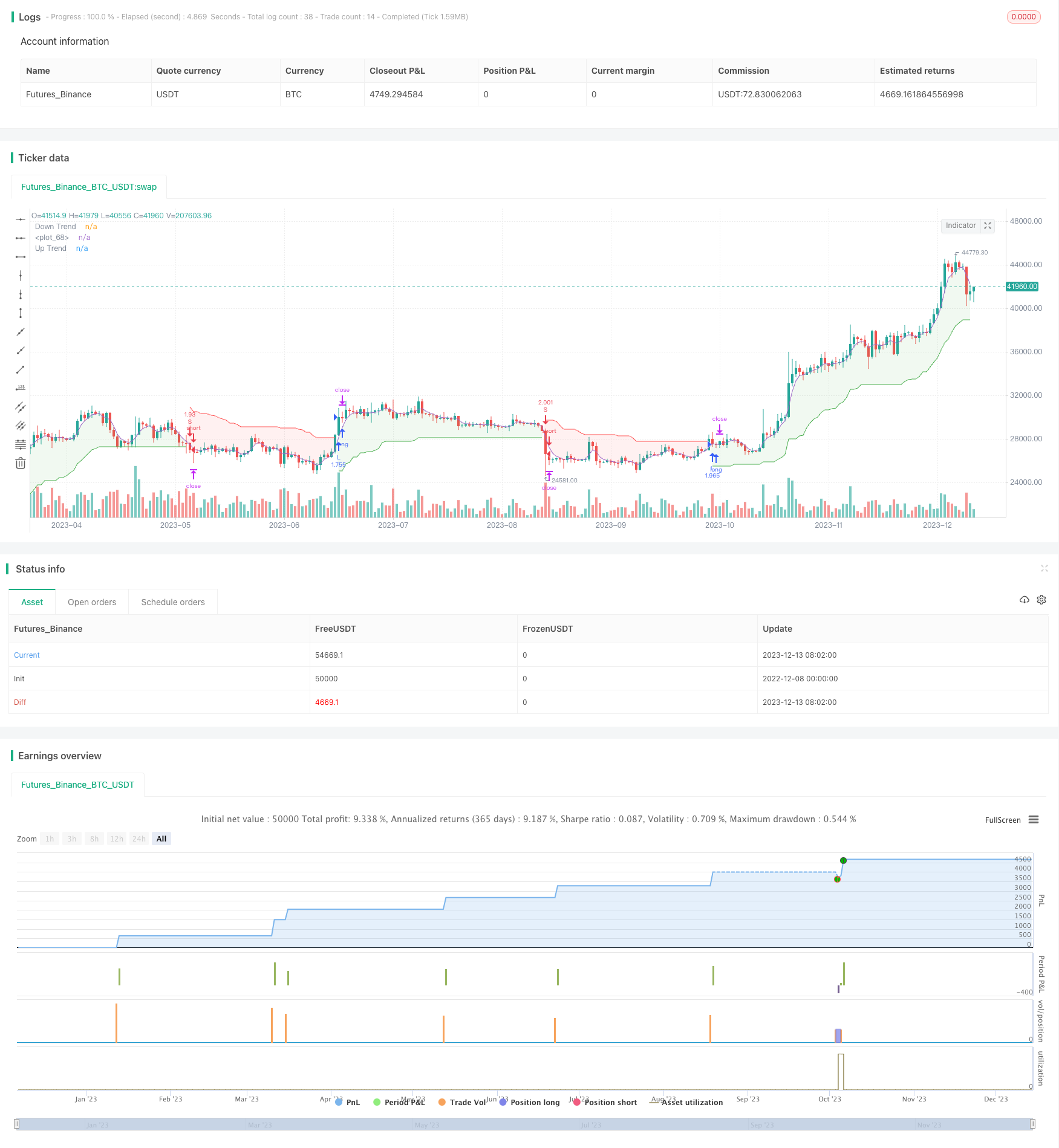
개요
이것은 Heiken Ashi와 슈퍼 트렌드 (Super Trend) 의 두 지표를 결합한 양적 거래 전략이다. 이 전략은 주로 Heiken Ashi 평형 K 선을 사용하여 시장 소음을 필터링하고, 슈퍼 트렌드 지표는 가격 트렌드 방향을 판단하여 트렌드 추적을 구현한다.
전략 원칙
- Heiken Ashi 지표를 사용하여 K선으로 처리하여 일부 시장 소음을 필터링하여 트렌드를 더 명확하게합니다.
- ATR 및 인수 계산에 기반한 슈퍼 트렌드의 오르락 내리락
- 가격이 상승할 때 하향 신호, 하락할 때 상향 신호
- 더 큰 인자, 더 적은 슈퍼 트렌드 신호, 더 나은 추적 효과, 그러나 진입 횟수 감소
- 하이켄 아시와 슈퍼 트렌드 지표가 결합되어 트렌드를 판단하고 추적합니다.
전략적 이점
- Heiken Ashi 지표는 시장의 일부 소음을 효과적으로 필터링하여 그래프를 더 명확하게 만듭니다.
- 슈퍼 트렌드 지표 파라미터 최적화 효과가 좋으며, 입점 주파수를 유연하게 조정할 수 있다.
- 두 개의 지표가 조합되어 가격 추세를 더 잘 판단할 수 있습니다.
- 강력한 트렌드를 자동으로 추적합니다.
전략적 위험
- 지표 포트폴리지는 거래의 정렬 간격의 잘못된 신호를 완전히 피할 수 없습니다.
- 큰 점프로 인해 지표가 작동하지 않아 중요한 신호를 놓칠 수 있습니다.
- 슈퍼 트렌드 요소는 컨퍼런스를 설정하고 트렌드 기회를 놓치고 있습니다.
해결책: (1) 슈퍼 트렌드 매개 변수를 적절히 조정하여 추적 효과와 출입 횟수를 균형 잡습니다. (2) 다른 지표들을 추가하여 판단에 도움을 주고, 도약의 문제를 피하는 것.
전략 최적화 방향
- ATR 주기와 슈퍼 트렌드 인자를 조정하여 입시 빈도를 최적화하십시오.
- 단편적 손실을 통제하기 위한 스톱로스 지표를 늘리세요.
- 다른 지표와 결합하여 트렌드 유형을 판단하여 트렌드 흔들림 리듬을 잘못 처리하는 것을 피하십시오.
- 기계 학습 알고리즘을 추가하여 방향을 결정하는 데 도움을 줍니다.
요약하다
이 전략은 Heiken Ashi와 슈퍼 트렌드 이중 지표의 장점을 통합하여 지표를 사용하여 가치 트렌드 방향을 판단하여 자동 추적을 구현한다. 특정 지표를 사용하는 것에 비해 가격 움직임을 판단하는 효과는 더 좋으며 전략의 안정성을 강화한다. 물론, 개선할 여지가 있으며, 향후에는 진입 빈도, 손실 중단 측면에서 최적화하여 전략 수익률이 높고 위험도가 낮아진다.
전략 소스 코드
/*backtest
start: 2022-12-08 00:00:00
end: 2023-12-14 00:00:00
period: 1d
basePeriod: 1h
exchanges: [{"eid":"Futures_Binance","currency":"BTC_USDT"}]
*/
// This source code is subject to the terms of the Mozilla Public License 2.0 at https://mozilla.org/MPL/2.0/
// © RingsCherrY
//@version=5
strategy("Heiken Ashi & Super Trend", overlay=true, pyramiding=1,initial_capital = 10000, default_qty_type= strategy.percent_of_equity, default_qty_value = 100, calc_on_order_fills=false, slippage=0,commission_type=strategy.commission.percent,commission_value=0.02)
///////////////////////////////////////////////////
////////////////////Function///////////////////////
///////////////////////////////////////////////////
heikinashi_open = request.security(ticker.heikinashi(syminfo.tickerid), timeframe.period, open)
heikinashi_high = request.security(ticker.heikinashi(syminfo.tickerid), timeframe.period, high)
heikinashi_low = request.security(ticker.heikinashi(syminfo.tickerid), timeframe.period, low)
heikinashi_close= request.security(ticker.heikinashi(syminfo.tickerid), timeframe.period, close)
heikinashi_color = heikinashi_open < heikinashi_close ? #53b987 : #eb4d5c
// plotbar(heikinashi_open, heikinashi_high, heikinashi_low, heikinashi_close, color=heikinashi_color)
x_sma(x, y) =>
sumx = 0.0
for i = 0 to y - 1
sumx := sumx + x[i] / y
sumx
x_rma(src, length) =>
alpha = 1/length
sum = 0.0
sum := na(sum[1]) ? x_sma(src, length) : alpha * src + (1 - alpha) * nz(sum[1])
x_atr(length) =>
trueRange = na(heikinashi_high[1])? heikinashi_high-heikinashi_low : math.max(math.max(heikinashi_high - heikinashi_low, math.abs(heikinashi_high - heikinashi_close[1])), math.abs(heikinashi_low - heikinashi_close[1]))
//true range can be also calculated with ta.tr(true)
x_rma(trueRange, length)
x_supertrend(factor, atrPeriod) =>
src = (heikinashi_high+heikinashi_low)/2
atr = x_atr(atrPeriod)
upperBand = src + factor * atr
lowerBand = src - factor * atr
prevLowerBand = nz(lowerBand[1])
prevUpperBand = nz(upperBand[1])
lowerBand := lowerBand > prevLowerBand or heikinashi_close[1] < prevLowerBand ? lowerBand : prevLowerBand
upperBand := upperBand < prevUpperBand or heikinashi_close[1] > prevUpperBand ? upperBand : prevUpperBand
int direction = na
float superTrend = na
prevSuperTrend = superTrend[1]
if na(atr[1])
direction := 1
else if prevSuperTrend == prevUpperBand
direction := heikinashi_close > upperBand ? -1 : 1
else
direction := heikinashi_close < lowerBand ? 1 : -1
superTrend := direction == -1 ? lowerBand : upperBand
[superTrend, direction]
///////////////////////////////////////////////////
////////////////////Indicators/////////////////////
///////////////////////////////////////////////////
atrPeriod = input(10, "ATR Length")
factor = input.float(3.0, "Factor", step = 0.01)
[supertrend, direction] = x_supertrend(factor, atrPeriod)
bodyMiddle = plot((heikinashi_open + heikinashi_close) / 2, display=display.none)
upTrend = plot(direction < 0 ? supertrend : na, "Up Trend", color = color.green, style=plot.style_linebr)
downTrend = plot(direction < 0? na : supertrend, "Down Trend", color = color.red, style=plot.style_linebr)
fill(bodyMiddle, upTrend, color.new(color.green, 90), fillgaps=false)
fill(bodyMiddle, downTrend, color.new(color.red, 90), fillgaps=false)
///////////////////////////////////////////////////
////////////////////Strategy///////////////////////
///////////////////////////////////////////////////
var bool longCond = na, var bool shortCond = na, longCond := nz(longCond[1]), shortCond := nz(shortCond[1])
var int CondIni_long = 0, var int CondIni_short = 0, CondIni_long := nz(CondIni_long[1]), CondIni_short := nz(CondIni_short[1])
var float open_longCondition = na, var float open_shortCondition = na
long = ta.change(direction) < 0
short = ta.change(direction) > 0
longCond := long
shortCond := short
CondIni_long := longCond[1] ? 1 : shortCond[1] ? -1 : nz(CondIni_long[1])
CondIni_short := longCond[1] ? 1 : shortCond[1] ? -1 : nz(CondIni_short[1])
longCondition = (longCond[1] and nz(CondIni_long[1]) == -1)
shortCondition = (shortCond[1] and nz(CondIni_short[1]) == 1)
open_longCondition := long ? close[1] : nz(open_longCondition[1])
open_shortCondition := short ? close[1] : nz(open_shortCondition[1])
//TP
tp = input.float(1.1 , "TP [%]", step = 0.1)
//BACKTESTING inputs --------------------------------------------------------------------------------------------------------------------------------------------------------------------------------------------------------------------------------------------------------------------------------------------------------
testStartYear = input.int(2000, title="start year", minval = 1997, maxval = 3000, group= "BACKTEST")
testStartMonth = input.int(01, title="start month", minval = 1, maxval = 12, group= "BACKTEST")
testStartDay = input.int(01, title="start day", minval = 1, maxval = 31, group= "BACKTEST")
testPeriodStart = timestamp(testStartYear,testStartMonth,testStartDay,0,0)
testStopYear = input.int(3333, title="stop year", minval=1980, maxval = 3333, group= "BACKTEST")
testStopMonth = input.int(12, title="stop month", minval=1, maxval=12, group= "BACKTEST")
testStopDay = input.int(31, title="stop day", minval=1, maxval=31, group= "BACKTEST")
testPeriodStop = timestamp(testStopYear, testStopMonth, testStopDay, 0, 0)
testPeriod = true
// Backtest ==================================================================================================================================================================================================================================================================================================================================
if longCond
strategy.entry("L", strategy.long, when=testPeriod)
if shortCond
strategy.entry("S", strategy.short, when=testPeriod)
strategy.exit("TP_L", "L", profit =((open_longCondition * (1+(tp/100))) - open_longCondition)/syminfo.mintick)
strategy.exit("TP_S", "S", profit =((open_shortCondition * (1+(tp/100))) - open_shortCondition)/syminfo.mintick)